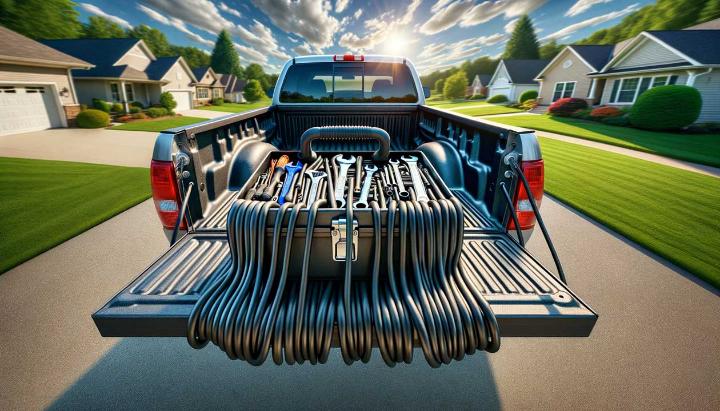Have you ever wondered how such a simple tool as a shock cord bungee can hold so much power and versatility? From securing your camping gear to enhancing your workout routine, shock cord bungees are indispensable in countless situations. But with great elasticity and strength comes the need for safety precautions to avoid potential hazards. In this blog post, we’ll explore essential safety tips for using shock cord bungees, ensuring you can harness their capabilities without compromising on safety. Stay tuned to learn more about the properties of shock cord bungees, how to inspect and maintain them, and the best practices for safe usage in various applications.
Understanding the Properties of Shock Cord Bungee
Shock cord bungees, also known as bungee cords or elasticated cords, are versatile and highly useful tools that find applications in various settings. At their core, they consist of a multi-stranded rubber inner core covered by a durable synthetic or cotton outer jacket. This unique construction gives shock cord bungees their remarkable properties and makes them indispensable for many tasks.
What is a Shock Cord Bungee?
A shock cord bungee is an elastic cord with a highly stretchable rubber core that provides its renowned flexibility and stretchability. The rubber core is encased in a tough outer sheath, typically made of synthetic or cotton materials, which protects the core and enhances the cord's durability. This combination of an elastic core and a tough outer layer is what makes shock cord bungees so versatile and suitable for a wide range of applications, from securing loads to bungee jumping, and even in model rocketry.

Key Shock Cord Bungee Properties
- Stretchability/elongation: One of the most remarkable properties of shock cord bungees is their ability to stretch, typically up to 125% of their original length. This stretchability allows them to absorb shock and distribute force evenly, making them ideal for securing loads or providing a cushioning effect.
- Tensile strength: Despite their stretchability, shock cord bungees are designed to withstand significant tension and weight. Their multi-stranded rubber core and durable outer jacket work together to provide exceptional tensile strength, ensuring they can handle even the most demanding applications.
- Abrasion resistance: The tough outer sheath of shock cord bungees protects the rubber core from abrasion, wear, and tear, ensuring their longevity even in harsh environments or under continuous use.
- Environmental resistance: The latex rubber core of shock cord bungees is resistant to sunlight and air, preventing degradation and maintaining its elasticity over time, even when exposed to outdoor elements.
These properties make shock cord bungees ideal for a wide range of applications, from securing gear and tethering tools to providing shock absorption in bungee jumping and model rocketry. Understanding these key properties is crucial for selecting the right shock cord bungee for your specific needs and ensuring safe and effective use.
Applications of Shock Cord Bungees
Shock cord bungees find applications in various industries and activities, thanks to their unique combination of stretchability, strength, and durability. Some common applications include:
- Tethering tools and securing gear: The stretchability and strength of shock cord bungees make them perfect for tethering tools or securing gear in place, ensuring they don't get lost or misplaced during use.
- Bungee jumping: The ability of shock cord bungees to stretch and absorb shock is essential in the adrenaline-fueled sport of bungee jumping, where they provide the necessary safety and cushioning for participants.
- Model rocketry: In model rocketry, shock cord bungees are used to connect the rocket to the parachute, ensuring a safe and controlled descent after launch.
Beyond these common applications, shock cord bungees can also be used in various recreational activities, such as camping, hiking, or even exercise routines. Their versatility and adaptability make them valuable tools in many scenarios where stretchability, strength, and durability are required.
Inspecting and Maintaining Your Shock Bungee Cord
Shock bungee cords, also known as bungee cords or elasticated cords, are incredibly versatile tools that can be used in a variety of settings, from securing gear to providing shock absorption in extreme sports. However, like any piece of equipment, proper inspection and maintenance are crucial to ensuring the safety and longevity of your shock bungee cords.
What is a Shock Bungee Cord?
A shock bungee cord is a stretchy, elastic cord with a highly flexible rubber core encased in a durable outer sheath, typically made of synthetic or cotton materials. This unique construction gives shock bungee cords their remarkable stretchability and tensile strength, making them perfect for applications that require shock absorption or load securing.
Whether you're using a shock bungee cord for tethering tools, securing cargo during transportation, or even for recreational activities like bungee jumping or model rocketry, understanding its construction and proper maintenance is essential for your safety and the cord's longevity.

How to Inspect a Shock Bungee Cord
Before using a shock bungee cord, it's crucial to inspect it for any signs of wear or damage. Here's how to properly inspect your shock bungee cord:
- Visual inspection: Start by carefully examining the entire length of the cord, paying close attention to the outer sheath. Look for any fraying, cuts, or excessive wear, especially at the contact points or areas that experience frequent friction.
- Check for narrowing (necking): Stretch the cord gently and look for any areas where the diameter appears to be narrowing or "necking." This could indicate internal damage to the rubber core, which can compromise the cord's strength and stretchability.
- Lighting and angle: Inspect the cord from different angles and under good lighting conditions to ensure you don't miss any subtle signs of damage or wear.
- Stretch test: Gently stretch the cord to check its elasticity. If it feels stiff or doesn't return to its original length, it may be time to replace the cord.
If you notice any significant damage, fraying, or loss of elasticity, it's best to replace the shock bungee cord immediately. Using a compromised cord could lead to potential safety hazards or failure during use.
Proper Maintenance of Shock Bungee Cords
Proper maintenance is key to extending the life of your shock bungee cords. Here are some tips to keep your cords in top condition:
- Regular cleaning: Periodically clean your shock bungee cords to remove dirt, grime, and debris that can accelerate wear and tear. Use a mild soap and water solution, and avoid harsh chemicals or solvents that could damage the materials.
- Proper storage: Store your shock bungee cords in a cool, dry place away from direct sunlight and extreme temperatures. Avoid storing them under tension or with kinks or twists, as this can weaken the fibers over time.
- Replacement: Even with proper care, shock bungee cords will eventually need to be replaced due to natural wear and tear. Keep an eye on the condition of your cords and replace them promptly if they show signs of significant deterioration or loss of elasticity.
By following these simple guidelines for inspection and maintenance, you can ensure that your shock bungee cords remain safe, reliable, and ready for action, no matter what adventure or task lies ahead.
Safe Shock Cord Bungee Usage Techniques
Shock cord bungees, also known as bungee cords or elastic shock cords, are incredibly versatile tools that can make our lives easier in countless ways. From securing loads during transportation to adding resistance for exercise routines, these stretchy and durable cords have become a staple in many households and industries. However, as with any tool, it's crucial to understand and follow proper safety protocols when working with shock cord bungees to prevent accidents and injuries.
Securing Shock Cords and Bungee Cords Safely
One of the most important aspects of using shock cord bungees safely is ensuring they are securely attached to anchor points or objects. Imagine the chaos that could ensue if a bungee cord holding down a load in your truck suddenly snapped loose while driving! Here are some tips for securely attaching these elastic cords:

- Use proper securing methods: Depending on the application, you may need to use hog rings, carabiners, knots, or adhesives to securely fasten the shock cord bungee to anchor points or objects.
- Double-check connections: Before using a bungee cord, always double-check that it's properly secured and won't come loose unexpectedly.
- Inspect for wear and tear: Regularly inspect your shock cord bungees for signs of fraying, cuts, or other damage that could compromise their strength and integrity. Replace them if necessary.
Remember, a loose or failing bungee cord can pose serious safety risks, so it's always better to err on the side of caution and ensure your connections are secure and the cords are in good condition.
Common Shock Cord and Bungee Cord Applications
Shock cord bungees can be incredibly handy in a variety of situations. Here are some common applications where you might find them useful:
- Securing loads during transportation: Whether you're moving furniture, hauling gear, or transporting cargo, bungee cords can help keep your loads securely in place, preventing them from shifting or falling off.
- Exercise equipment: Many at-home exercise routines and gym equipment incorporate bungee cords to provide resistance and enhance workouts.
- Cable management: In offices, workshops, or even at home, bungee cords can help keep cables and wires organized and tidy, preventing tangling and clutter.
- Camping and outdoor activities: From securing tent poles to tethering gear, these stretchy cords are a must-have for any outdoor adventurer.
The versatility of shock cord bungees is one of their greatest strengths, but it's important to understand the specific safety considerations for each application to ensure you're using them correctly and minimizing risks.
Tips for Preventing Injuries with Bungee Cords
While shock cord bungees are generally safe when used properly, their elastic nature and potential for recoil can pose risks if not handled with care. Here are some tips to help prevent injuries when working with bungee cords:
- Stay focused and alert: Bungee cords can snap back unexpectedly, so it's important to maintain concentration and awareness of your surroundings when using them.
- Keep vulnerable body parts clear: Avoid placing your hands, face, or other vulnerable areas in the potential recoil path of a stretched bungee cord.
- Use protective gear: Depending on the application, consider wearing gloves, eye protection, or other safety gear to minimize the risk of injury.
- Follow manufacturer guidelines: Always read and follow the manufacturer's instructions and safety guidelines for your specific shock cord bungee products.
Safety should always be your top priority when working with shock cord bungees. A little caution and common sense can go a long way in preventing accidents and ensuring your projects run smoothly.
By following these safe usage techniques and injury prevention tips, you can enjoy the convenience and versatility of shock cord bungees while minimizing the risks associated with their use. Remember, safety should always be your top priority when working with these elastic cords, and a little caution and common sense can go a long way in preventing accidents and ensuring your projects run smoothly.
Common Applications and Precautions for Shock Cord Bungee
Shock cord bungees, also known as bungee cords or elastic cords, are incredibly versatile tools that have become a staple in many households and industries. Their unique combination of stretchability, strength, and durability makes them ideal for a wide range of applications, from securing loads during transportation to adding resistance for exercise routines.
But with this versatility comes the need for caution and a clear understanding of the proper usage and safety precautions. After all, these stretchy cords pack quite a punch, and mishandling them could lead to accidents, injuries, or property damage.

Versatile Applications of Shock Cord Bungee
Have you ever had to transport bulky items or move furniture and wished you had a simple way to keep everything secure? Or perhaps you've been looking for a way to add some resistance to your exercise routine? These are just a few of the many scenarios where shock cord bungees can come in handy.
Here are some of the most common applications for these stretchy cords:
- Securing loads during transportation: Whether you're moving furniture, hauling gear, or transporting cargo, bungee cords can help keep your loads securely in place, preventing them from shifting or falling off. For even more durability, consider options like high-strength tow ropes.
- Exercise equipment: Many at-home exercise routines and gym equipment incorporate bungee cords to provide resistance and enhance workouts, adding an extra challenge to your fitness routine. See the benefits of similar products like synthetic ropes.
- Cable management: In offices, workshops, or even at home, bungee cords can help keep cables and wires organized and tidy, preventing tangling and clutter.
- Camping and outdoor activities: From securing tent poles to tethering gear, these stretchy cords are a must-have for any outdoor adventurer, ensuring your equipment stays put no matter the terrain.
The possibilities are endless, and their versatility is one of the greatest strengths of shock cord bungees. But remember, with great power comes great responsibility – or in this case, the responsibility to use these cords safely and responsibly.
Essential Safety Precautions for Bungee Cords
While shock cord bungees are generally safe when used properly, their elastic nature and potential for recoil can pose risks if not handled with care. Here are some essential safety precautions to keep in mind when working with bungee cords:
- Inspect for damage: Before using a bungee cord, always inspect it for any signs of damage, fraying, or wear. A compromised cord could snap unexpectedly, putting you and your surroundings at risk.
- Stand clear of the stretch path: When stretching a bungee cord, make sure to stand clear of its potential recoil path. These cords can snap back with considerable force, and you don't want to be in their line of fire.
- Avoid kinks and tangles: Kinks, twists, and tangles can significantly weaken the strength of a bungee cord, increasing the risk of failure. Always keep your cords neat and tangle-free.
- Use proper attachment points: When securing bungee cords, make sure to use appropriate hooks or attachment points that can withstand the tension and force involved. Improper attachments could lead to the cord coming loose unexpectedly.
- Consider stretch length and tension: Different applications may require varying stretch lengths and tensions. Always consider the maximum stretch and tension the cord can handle before using it for a specific task.
By following these essential safety precautions, you can enjoy the convenience and versatility of shock cord bungees while minimizing the risks associated with their use. Remember, a little caution and common sense can go a long way in preventing accidents and ensuring your projects run smoothly.
Shock cord bungees, known for their high elasticity, are indispensable in various settings, from securing loads to recreational uses. Follow essential safety tips such as selecting the correct size and strength, performing regular inspections, and using proper securing techniques to prevent accidents. Whether you're using shock bungee cords for transportation, exercise, or camping, prioritising safety ensures longevity and effectiveness. Remember to inspect for wear, handle with care, and replace when necessary. For customised solutions tailored to your specific needs, fill out the form above and let our experts guide you.